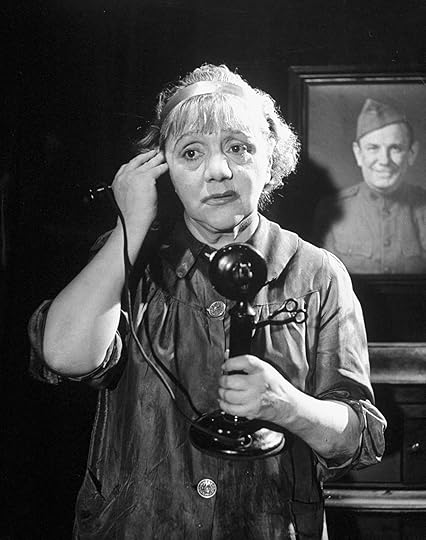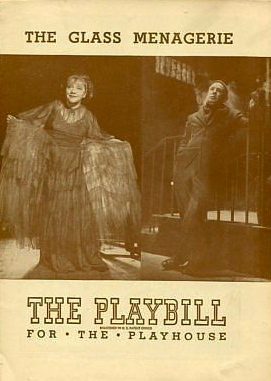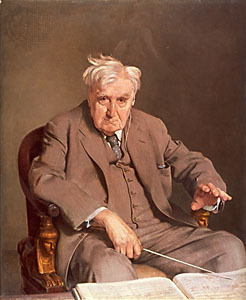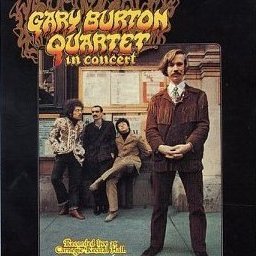Terry Teachout's Blog, page 181
February 6, 2012
TT: Down the road a piece
 Today is my fifty-sixth birthday. So what?
Today is my fifty-sixth birthday. So what?Hitting the double nickel last year inspired me to hold forth at length about this and that, not entirely without reason, seeing as how my first play and second opera were both premiered in 2011. Alas, 56 is a thoroughly uninteresting number, and 2012, while it holds a major event in store for me, promises to be routine in other respects. Assuming that nothing cataclysmic intervenes, I'll write a hundred-odd pieces, see a hundred-odd plays, spend a lot of time waiting impatiently in departure lounges, and--I hope--finish the first draft of Mood Indlgo: A Life of Duke Ellington. For me that's standard stuff, and I'm not sure I'd want it any other way, though I do have three never-to-be-acknowledged dreams that I hope will come true between now and year's end. The first is probable, the second not altogether unlikely, while the third is a dismayingly long shot. (None has anything to do with Satchmo at the Waldorf, in case you're wondering.)
Birthdays per se don't mean much to me anymore, save as unwanted reminders of the inexorable approach of the Distinguished Thing. Six years after meeting Mrs. T and surviving a brush with death , I no longer need to be reminded to use well the interval: I've got that down pat, though I seize some days more firmly than others. In fact, I'm much more in need of regular reminders of the value of leisure, at which I'm not nearly good enough. If a philanthropist with money to spare were to offer me a smallish chunk of it, I'd ask my employers for a leave of absence and take Mrs. T on a nice long trip, in the course of which I'd endeavor to write as little as possible. But even the longest, loveliest vacation must end sooner or later, and no sooner would we return home than I'd sit down at my desk and go back to work...and do what?
 It isn't quite right to say that I feel the need for a change, since the past few years have been so full of changes. Perhaps a better way to put it is that I'm trying to decide how I want to spend the next part (which may, of course, be the last part) of my life. What shall I do once Satchmo at the Waldorf opens in Lenox and the manuscript of Mood Indigo is shipped off to Gotham Books? Should I embark on yet another biography? Ought I to continue working as a critic? Might I want to try my hand at teaching? Is my first venture into playwriting destined to be a one-shot affair? Above all, I long to know the answer to this question: are my energies best spent as a jack-of-all-trades, or has the time come at last for me to direct my fire at a single target?
It isn't quite right to say that I feel the need for a change, since the past few years have been so full of changes. Perhaps a better way to put it is that I'm trying to decide how I want to spend the next part (which may, of course, be the last part) of my life. What shall I do once Satchmo at the Waldorf opens in Lenox and the manuscript of Mood Indigo is shipped off to Gotham Books? Should I embark on yet another biography? Ought I to continue working as a critic? Might I want to try my hand at teaching? Is my first venture into playwriting destined to be a one-shot affair? Above all, I long to know the answer to this question: are my energies best spent as a jack-of-all-trades, or has the time come at last for me to direct my fire at a single target?The longer I live, the surer I am that the world was made for specialists, and I've always been reluctant to settle into a pigeonhole, however commodious. When I played music, I played many kinds of music on more than one instrument. When I became a critic, I wrote about whatever interested me rather than concentrating on a single medium. When I became a biographer, I jumped from subject to subject (first a journalist, then a choreographer, then a jazzman). No sooner was my first opera libretto produced than I started writing my first play. Yes, it's been fun, but might I have been better served had I concentrated on one thing? While I don't think it's right to call me a dilettante--I've aspired to professional standards in everything to which I've set my hand--I sometimes wonder whether my reluctance to specialize has kept me from doing as well as I might have done in any of my varied lines of work.
 Even at fifty-six, it's not quite too late for me to change my ways, or at least modify them. It's well within the realm of possibility that I have twenty-odd years of comparatively undiminished energy ahead of me, and I want to use those years in the best and most satisfying way that I can. Up to now I've operated on the assumption that life itself would tell me what to do next. Will it do so yet again? Or ought I to take courage in hand and place all my chips on a single number? And if so, should it be one of the numbers on which I've successfully bet in the past--or would I do better to try something really different?
Even at fifty-six, it's not quite too late for me to change my ways, or at least modify them. It's well within the realm of possibility that I have twenty-odd years of comparatively undiminished energy ahead of me, and I want to use those years in the best and most satisfying way that I can. Up to now I've operated on the assumption that life itself would tell me what to do next. Will it do so yet again? Or ought I to take courage in hand and place all my chips on a single number? And if so, should it be one of the numbers on which I've successfully bet in the past--or would I do better to try something really different?Merely to write these words is to smile at their preposterous presumptuousness. I noted seven years ago that "nothing I imagined for myself when young has come to pass: everything is different, utterly so. I'm not a schoolteacher, not a jazz musician, not the chief music critic of a major metropolitan newspaper, not a syndicated columnist, not settled and secure." You'd think, then, that I'd know better than to suppose that I could ever point myself in any conceivable direction with a reasonable expectation of getting where I thought I wanted to go. Yet here I am, trying once again to figure out what my next move should be.
The truth is that my next few moves are already set in stone. I've got a book to finish and a play to see onto the stage, The Wall Street Journal still expects to hear from me six times a month, and Paul Moravec and I are just getting started on our third opera. Nor do I have any particularly bright ideas about what to do after that: I have yet to receive an offer of steady employment from a college or think tank, and no matter how well Satchmo at the Waldorf does this summer, I have no illusions about being able to make anything remotely approaching a living by writing plays, much less opera libretti.
In short, nothing has changed--yet. Maybe it won't, and maybe that'll be just fine. Or maybe not. Edward Steichen said it: "Every ten years or so, a man should give himself a good swift kick in the pants!" Am I due?
Published on February 06, 2012 05:00
TT: A sighting of the grail
 If you're a longtime reader of this blog, you might remember the following posting from 2005:
If you're a longtime reader of this blog, you might remember the following posting from 2005:Laurette Taylor's performance as Amanda Wingfield in the original 1945 production of Tennessee Williams' The Glass Menagerie is the most vividly remembered piece of acting ever to have taken place on an American stage. Yet nothing remains of it but memories and a few still photographs--some of which can be seen here--since Taylor made no sound films save for the brief screen test included in Broadway: The Golden Age (a documentary you've absolutely got to see, assuming you haven't already). The greatness of her acting is thus like the greatness of Nijinsky's dancing: all who saw her agree on it, but the rest of us must take it on faith.
Or...must we?
After reading that Times story, I did a bit of fugitive Googling, and found something that sent my jaw dropping floorward. It's from the Web site of the Harry Ransom Humanities Research Center at the University of Texas at Austin, which is where Taylor's private papers ended up. I was looking at the HRCRC's description of its Taylor collection when I stumbled onto this statement: "A number of published works and recordings were transferred to the HRHRC book collection....Taylor's recordings, mostly 78 RPM, include The Glass Menagerie (1945); a 1939 WJZ radio broadcast of Peg O' My Heart; Among My Souvenirs (1943); a segment of We The People (1945); a Rudy Vallee radio program (1939); and a very early 1913 voice recording trial done of Laurette Taylor in New York."
Excuse me? Am I the last to learn that that there is a sound recording of some portion of Taylor's legendary performance in The Glass Menagerie? Or is its existence not widely known to scholars of American theater in general and Tennessee Williams' work in particular?
Rick McKay, the producer of Broadway: The Golden Age, promptly wrote to assure me that no recording of the original production of The Glass Menagerie exists, in Austin or anywhere else. That, I assumed, was that.
Not so. Over the weekend I received the following e-mail from Reva Cooper, a New York-based arts publicist:
In 2005, you wrote about a Laurette Taylor recording from The Glass Menagerie, and asked if anyone knew where to locate it. I'd heard about it, too, saw your entry on a search about it, and am writing to tell you that I located the recording and just heard it at the Harry Ransom Center at the University of Texas at Austin. The librarian said that due to copyright restrictions, she wasn't allowed to put it online, so you have to go there to hear it....
The recording you're interested in is called We, the People, and is an awards ceremony where [Taylor] is honored by a journalism association. As part of the event she reads scenes from Peg o' My Heart, Outward Bound, and The Glass Menagerie, and discusses her preparation for each of these roles (the scenes aren't listed, and I just wrote to the librarian in followup to suggest that they be added to the index title, to make it easier to locate).
Her Amanda is fascinating, not at all like later Amandas I've seen, much more hardscrabble working class, living in the present in St. Louis, playing against the memory--but suddenly she remembers...and that's the surprise--much more realistic. And her accent is a bit more lower-class Southern than other actresses have used--she said she copied Tennessee Williams' accent.
This is--to put it very mildly--staggering news.
 Patricia Neal, who saw Taylor play Amanda Wingfield on Broadway, said in Broadway: The Golden Age that she gave "the greatest performance I have ever seen in all my life." According to Harold Prince, "I knew when I watched it, and I sat in the balcony, you'll never see greater acting as long as you live." Given the fact that countless other theater professionals who saw Laurette Taylor's Amanda in the theater have said pretty much the same thing, I can't imagine another hitherto-unknown archival document that would be of more compelling interest to scholars and aficionados of American theater in the twentieth century than a sound recording of Taylor reading a fragment of The Glass Menagerie, however brief. Would that I were in a position to catch the next plane to Austin!
Patricia Neal, who saw Taylor play Amanda Wingfield on Broadway, said in Broadway: The Golden Age that she gave "the greatest performance I have ever seen in all my life." According to Harold Prince, "I knew when I watched it, and I sat in the balcony, you'll never see greater acting as long as you live." Given the fact that countless other theater professionals who saw Laurette Taylor's Amanda in the theater have said pretty much the same thing, I can't imagine another hitherto-unknown archival document that would be of more compelling interest to scholars and aficionados of American theater in the twentieth century than a sound recording of Taylor reading a fragment of The Glass Menagerie, however brief. Would that I were in a position to catch the next plane to Austin!Alas, I'll be otherwise occupied for some time to come, so if anyone who sees this posting has in his possession an air check of the Laurette Taylor episode of We, the People, which aired on CBS from 1936 to 1951, would you please get in touch with me? I'm sure that I'll make it to Austin sooner or later, but later is more likely than sooner, and I'd prefer not to wait any longer than absolutely necessary in order to hear and report on this priceless memento of a great artist at the peak of her powers.
Published on February 06, 2012 05:00
TT: Just because
Caedmon's 1965 studio recording of Montgomery Clift performing the closing scene of The Glass Menagerie. The music, by Paul Bowles, was used in the original 1945 stage production:
An abridged radio performance of the first part of The Glass Menagerie, starring Clift, Helen Hayes, and Karl Malden, originally broadcast live in 1951 on Theater Guild on the Air:
The other parts of the broadcast are here , here , here , and here .
An abridged radio performance of the first part of The Glass Menagerie, starring Clift, Helen Hayes, and Karl Malden, originally broadcast live in 1951 on Theater Guild on the Air:
The other parts of the broadcast are here , here , here , and here .
Published on February 06, 2012 05:00
TT: Almanac
"A man can believe, and make his own, in the most genuine way, what he has received from another;--and with boundless gratitude to the other. The merit of originality is not novelty; it is sincerity. The believing man is the original man; whatsoever he believes, he believes it for himself, not for another."
Thomas Carlyle, "The Hero as Priest"
Thomas Carlyle, "The Hero as Priest"
Published on February 06, 2012 05:00
February 3, 2012
HOW CAN SKEPTICS MAKE GREAT RELIGIOUS ART?
"
Most of
the modern novelists who have placed matters of faith at the center of their work have been, like Graham Greene, C.S. Lewis, François Mauriac and Flannery O'Connor, believers of one sort or another. But in every other branch of art, great works of devotional art have been created by skeptics, not a few of whom were fire-breathingly militant about their doubt..."
Published on February 03, 2012 15:50
TT: Still angry after all these years
Today's Wall Street Journal drama column is devoted in its entirety to the Roundabout Theatre Company's revival of
Look Back in Anger
. Here's an excerpt.
* * *
It's disorienting to watch the film version of John Osborne's "Look Back in Anger" fifty-six years after the play on which it was based exploded onto the London stage. The history books assure us that Mr. Osborne swept away the genteel, well-made drawing-room comedies that had long dominated British theater, replacing them with blunt expressions of pent-up rage against the class machine. Yet the first thing you see on screen is an all-white, banjo-powered Dixieland band, for New Orleans-style jazz was the preferred music of England's "angry young men," as Mr. Osborne and his fellow rebels soon came to be known, back in the benighted days before the arrival of John, Paul, George and Ringo.
 That's how dated "Look Back in Anger" is, and that's why it's surprising that the Roundabout Theatre Company's new revival, staged with flame-throwing éclat by Sam Gold, should be so theatrically potent. For not only is Mr. Osborne's first play a period piece, but it is an ultra-British period piece, one whose author, not surprisingly, failed to make a lasting impression on American theatergoers. No play of his has been seen on Broadway since 1969. Indeed, "Look Back in Anger" is being mounted at the Laura Pels Theatre rather than in one of the company's Broadway houses, which suggests a certain lack of confidence about its prospects at the box office.
That's how dated "Look Back in Anger" is, and that's why it's surprising that the Roundabout Theatre Company's new revival, staged with flame-throwing éclat by Sam Gold, should be so theatrically potent. For not only is Mr. Osborne's first play a period piece, but it is an ultra-British period piece, one whose author, not surprisingly, failed to make a lasting impression on American theatergoers. No play of his has been seen on Broadway since 1969. Indeed, "Look Back in Anger" is being mounted at the Laura Pels Theatre rather than in one of the company's Broadway houses, which suggests a certain lack of confidence about its prospects at the box office.
This lack of confidence is understandable, since "Look Back in Anger" is culture-specific and time-bound in a way that presents real problems of understanding to Americans, especially those under 50, who know little of what England was like in 1956. But an effective production can overcome at least some of these problems, and this one is up to the mark, not least because Mr. Gold has fielded a top-of-the-line cast led by Matthew Rhys, who is so exciting as Jimmy Porter, Mr. Osborne's anti-hero and alter ego, that you'll likely be inclined to take his self-lacerating anger for granted rather than trying to puzzle out its source...
I suspect that the first half of "Look Back in Anger" is too deeply rooted in its time and place ever to be fully intelligible to the ordinary American theatergoer. If, on the other hand, you're capable of making sense of such postwar English novels as, say, Kingsley Amis' "Lucky Jim," then you'll have a pretty good idea of what's going on, and Mr. Gold's direction is so passionately precise that it contrives to make most of the rough places plain enough....
* * *
Read the whole thing here .
The opening scene of the 1958 film version of Look Back in Anger:
* * *
It's disorienting to watch the film version of John Osborne's "Look Back in Anger" fifty-six years after the play on which it was based exploded onto the London stage. The history books assure us that Mr. Osborne swept away the genteel, well-made drawing-room comedies that had long dominated British theater, replacing them with blunt expressions of pent-up rage against the class machine. Yet the first thing you see on screen is an all-white, banjo-powered Dixieland band, for New Orleans-style jazz was the preferred music of England's "angry young men," as Mr. Osborne and his fellow rebels soon came to be known, back in the benighted days before the arrival of John, Paul, George and Ringo.
 That's how dated "Look Back in Anger" is, and that's why it's surprising that the Roundabout Theatre Company's new revival, staged with flame-throwing éclat by Sam Gold, should be so theatrically potent. For not only is Mr. Osborne's first play a period piece, but it is an ultra-British period piece, one whose author, not surprisingly, failed to make a lasting impression on American theatergoers. No play of his has been seen on Broadway since 1969. Indeed, "Look Back in Anger" is being mounted at the Laura Pels Theatre rather than in one of the company's Broadway houses, which suggests a certain lack of confidence about its prospects at the box office.
That's how dated "Look Back in Anger" is, and that's why it's surprising that the Roundabout Theatre Company's new revival, staged with flame-throwing éclat by Sam Gold, should be so theatrically potent. For not only is Mr. Osborne's first play a period piece, but it is an ultra-British period piece, one whose author, not surprisingly, failed to make a lasting impression on American theatergoers. No play of his has been seen on Broadway since 1969. Indeed, "Look Back in Anger" is being mounted at the Laura Pels Theatre rather than in one of the company's Broadway houses, which suggests a certain lack of confidence about its prospects at the box office.This lack of confidence is understandable, since "Look Back in Anger" is culture-specific and time-bound in a way that presents real problems of understanding to Americans, especially those under 50, who know little of what England was like in 1956. But an effective production can overcome at least some of these problems, and this one is up to the mark, not least because Mr. Gold has fielded a top-of-the-line cast led by Matthew Rhys, who is so exciting as Jimmy Porter, Mr. Osborne's anti-hero and alter ego, that you'll likely be inclined to take his self-lacerating anger for granted rather than trying to puzzle out its source...
I suspect that the first half of "Look Back in Anger" is too deeply rooted in its time and place ever to be fully intelligible to the ordinary American theatergoer. If, on the other hand, you're capable of making sense of such postwar English novels as, say, Kingsley Amis' "Lucky Jim," then you'll have a pretty good idea of what's going on, and Mr. Gold's direction is so passionately precise that it contrives to make most of the rough places plain enough....
* * *
Read the whole thing here .
The opening scene of the 1958 film version of Look Back in Anger:
Published on February 03, 2012 05:00
TT: Agnostics in paradise
In today's Wall Street Journal "Sightings" column, inspired by a scene in the Roundabout Theatre Company's revival of
Look Back in Anger
, I consider the seeming paradox of religious art created by skeptics. Here's an excerpt.
* * *
Rarely have I seen a spectacle so disheartening as the cheerless, trash-strewn one-room flat that serves as the set for the Roundabout Theatre Company's Off-Broadway revival of John Osborne's "Look Back in Anger." In this production, reviewed elsewhere in today's Journal, the only hint of beauty comes from the radio on which the play's unhappy characters listen to Ralph Vaughan Williams' radiant Fifth Symphony. Small wonder that it should offer them a glimpse of comfort and joy in the midst of their emotional turmoil. Like so much of Vaughan Williams' music, the Fifth Symphony, which was composed during World War II, is deeply spiritual in tone, and it's no surprise to learn that it was based on themes from his operatic version of "The Pilgrim's Progress."
 Here's the surprise: Vaughan Williams was a lifelong agnostic.
Here's the surprise: Vaughan Williams was a lifelong agnostic.
Now that the boutique atheism of such aggressive secularists as Richard Dawkins, Sam Harris and Christopher Hitchens has become chic, you might well find yourself wondering why any unbelieving artist would bother to turn his hand to the making of religious art. Indeed, most of the modern novelists who have placed matters of faith at the center of their work have been, like Graham Greene, C.S. Lewis, François Mauriac and Flannery O'Connor, believers of one sort or another. But in every other branch of art, great works of devotional art have been created by skeptics, not a few of whom were fire-breathingly militant about their doubt....
How can such folk take up their tools in the name of God--and why would they want to do so? If you're a person of faith, the answer is obvious: They are guided by divine grace, which theologians assure us can be perceived partially or not at all. But there are other explanations....
* * *
Read the whole thing here .
Sir Adrian Boult conducts the London Philharmonic in the first movement of Vaughan Williams' Fifth Symphony:
* * *
Rarely have I seen a spectacle so disheartening as the cheerless, trash-strewn one-room flat that serves as the set for the Roundabout Theatre Company's Off-Broadway revival of John Osborne's "Look Back in Anger." In this production, reviewed elsewhere in today's Journal, the only hint of beauty comes from the radio on which the play's unhappy characters listen to Ralph Vaughan Williams' radiant Fifth Symphony. Small wonder that it should offer them a glimpse of comfort and joy in the midst of their emotional turmoil. Like so much of Vaughan Williams' music, the Fifth Symphony, which was composed during World War II, is deeply spiritual in tone, and it's no surprise to learn that it was based on themes from his operatic version of "The Pilgrim's Progress."
 Here's the surprise: Vaughan Williams was a lifelong agnostic.
Here's the surprise: Vaughan Williams was a lifelong agnostic.Now that the boutique atheism of such aggressive secularists as Richard Dawkins, Sam Harris and Christopher Hitchens has become chic, you might well find yourself wondering why any unbelieving artist would bother to turn his hand to the making of religious art. Indeed, most of the modern novelists who have placed matters of faith at the center of their work have been, like Graham Greene, C.S. Lewis, François Mauriac and Flannery O'Connor, believers of one sort or another. But in every other branch of art, great works of devotional art have been created by skeptics, not a few of whom were fire-breathingly militant about their doubt....
How can such folk take up their tools in the name of God--and why would they want to do so? If you're a person of faith, the answer is obvious: They are guided by divine grace, which theologians assure us can be perceived partially or not at all. But there are other explanations....
* * *
Read the whole thing here .
Sir Adrian Boult conducts the London Philharmonic in the first movement of Vaughan Williams' Fifth Symphony:
Published on February 03, 2012 05:00
TT: Nice guy
 In addition to being a great artist,
Pat Metheny
is also a very nice person. If you work in the arts, you'll know that these two things don't always go hand in hand. Because we both grew up in Missouri, I know that Pat's warm smile and unselfconscious sweetness of character, like the spacious, wide-open sound of his music, are deeply rooted in the friendly place where he was born and raised. It is, sad to say, quite possible for an unfriendly person to make beautiful music, but I like to think that the existence of such sour folk is an insult to the natural order of things. If so, then Pat Metheny makes up for Stan Getz or Benny Goodman.
In addition to being a great artist,
Pat Metheny
is also a very nice person. If you work in the arts, you'll know that these two things don't always go hand in hand. Because we both grew up in Missouri, I know that Pat's warm smile and unselfconscious sweetness of character, like the spacious, wide-open sound of his music, are deeply rooted in the friendly place where he was born and raised. It is, sad to say, quite possible for an unfriendly person to make beautiful music, but I like to think that the existence of such sour folk is an insult to the natural order of things. If so, then Pat Metheny makes up for Stan Getz or Benny Goodman.As I recently mentioned in this space, Pat came to Winter Park the other day to spend some time at Rollins College, my academic home away from home, and he and I made two joint appearances during his brief stay. On Wednesday Chuck Archard and I interviewed him in front of an audience, and on Thursday I moderated a question-and-answer session that followed a concert by Pat and Larry Grenadier, the bassist with whom he's spent the past few months barnstorming all over the world.
Pat flew directly from Japan to Florida on Tuesday. The mere fact that he managed to show up for Wednesday's session was thus more than a little bit astonishing. To say that he was exhausted is an understatement--his eyes were completely bloodshot--and I wouldn't have been at all surprised if he'd cut the evening short. Instead he let it run well into overtime, taking innumerable questions from the audience and answering them with the unfailingly courteous aplomb for which he is legendary among journalists.
I doubt you'll be entirely surprised to learn that not all non-verbal artists are at home in the world of words. I've written profiles of one or two well-known musicians who simply couldn't talk at all, thus forcing me to jump through hoops in order to create the illusion that they had something to say. Fortunately, Pat talks as well as he plays, and "interviewing" him is simply a matter of asking an occasional leading question, then scurrying out of the way. Everything he said on Wednesday was quotable, so much so that I'm planning to transform our chat into one of the Saturday Wall Street Journal's "cultural conversations" at some point in the next month or two. I guarantee that it'll be worth reading, and I can assure you that I won't deserve the least bit of credit for its readability.
 Midway through the evening, Pat praised my
Louis Armstrong biography
in a way that made me blush. I knew that he'd liked Pops, but to hear him say so in public was...well, let's just say that I'll treasure the memory as long as I live. As if that weren't enough of a thrill for one evening, Larry Coryell, Pat's illustrious predecessor in the legendary Gary Burton Quartet, happened to be in the audience on Wednesday. I couldn't believe my eyes when he raised his hand to ask Pat a question about harmony. It was as if William Faulkner were quizzing Flannery O'Connor.
Midway through the evening, Pat praised my
Louis Armstrong biography
in a way that made me blush. I knew that he'd liked Pops, but to hear him say so in public was...well, let's just say that I'll treasure the memory as long as I live. As if that weren't enough of a thrill for one evening, Larry Coryell, Pat's illustrious predecessor in the legendary Gary Burton Quartet, happened to be in the audience on Wednesday. I couldn't believe my eyes when he raised his hand to ask Pat a question about harmony. It was as if William Faulkner were quizzing Flannery O'Connor.Thursday's performance and post-concert colloquy were, if anything, even more exciting, and Larry turned out to be every bit as articulate as Pat. Mrs. T, who'd never heard Pat other than on record, was transported. Midway through "Change of Heart," she leaned over to me and said, "They're not here, are they? They're in the music." So they were--and so were we.
* * *
Gary Burton, Pat Metheny, Steve Swallow, and Antonio Sanchez play Metheny's "B & G (Midwestern Night's Dream)":
Published on February 03, 2012 05:00
TT: The Eames films (V)
This week I'm posting five films made by
Charles and Ray Eames
. Today's installment, Powers of Ten, was made in 1968:
Published on February 03, 2012 05:00
TT: Almanac
"Fashion is custom in the guise of departure from custom."
Edward Sapir, Fashion
Edward Sapir, Fashion
Published on February 03, 2012 05:00
Terry Teachout's Blog
- Terry Teachout's profile
- 45 followers
Terry Teachout isn't a Goodreads Author
(yet),
but they
do have a blog,
so here are some recent posts imported from
their feed.



